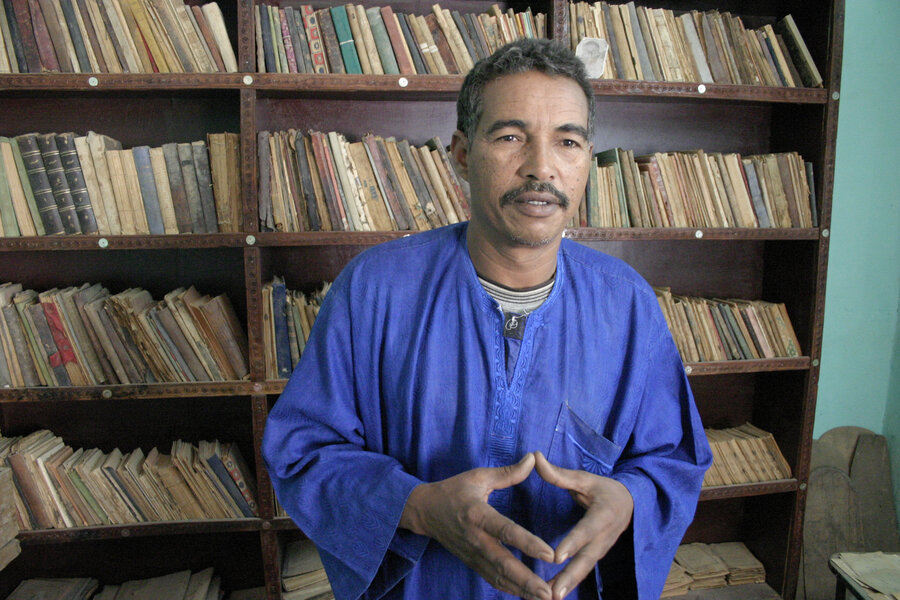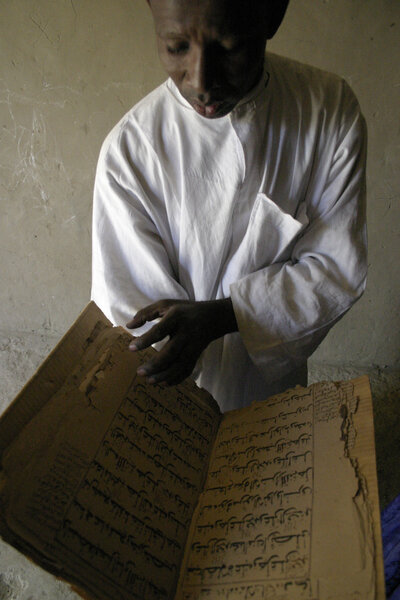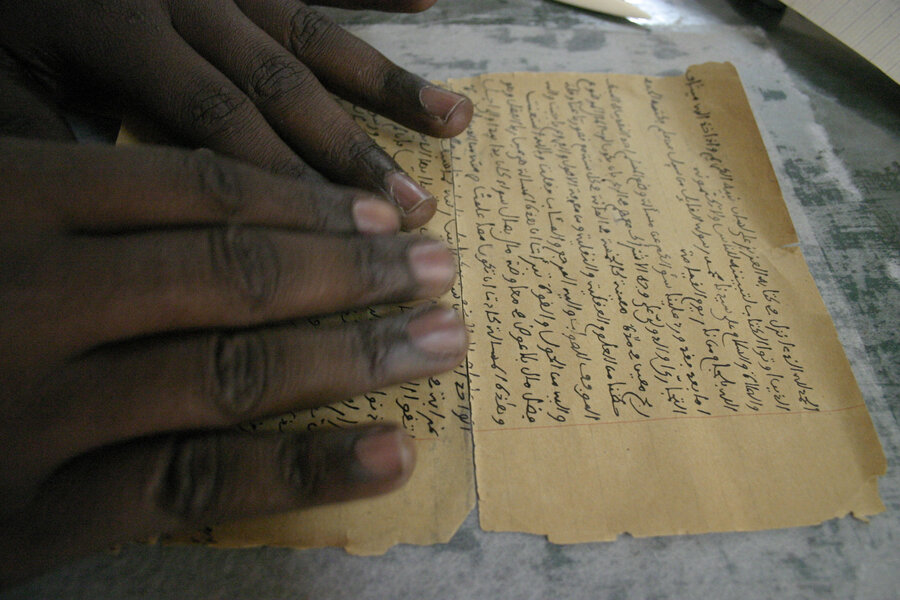In Timbuktu, a race to preserve Africa's written history
Loading...
| Timbuktu, Mali
Ahmed Saloum Boularaf is holding a leather-bound sheaf of documents that date back to the 13th century. The manuscript contains a poetic rendition of the life of the Prophet Mohammad, written in the lacy Arabic handwriting of an African scholar who knew how to read before some Europeans even knew of the existence of books.
Like most of the 1,700 manuscripts in Mr. Boularaf's private collection – which includes ancient books on medicine and history, astronomy and mathematics -- this one is beginning to crumble, and Boularaf knows that in a very short time, his manuscripts and the knowledge they contain, could be lost forever.
“For Africans, this is a treasury of our culture, and my home is open for all the researchers of the world to come,” he says. “My grandfather had the idea that we must copy these manuscripts before they are lost. We have some manuscripts here that are so fragile that if we don’t do something quickly to study them, conserve them, they could be lost.”
Depending on your perspective, Timbuktu is either the end of the world or, if you are coming from the desert, the first welcome sign of civilization. Once a great city of commerce, where camel caravans crossed the Sahara to trade slabs of salt in exchange for gold or slaves, Timbuktu was the meeting place of cultures.
At its height, from the 11th to the 15th centuries, it was a university town with vast libraries. Scientists here were postulating that the earth was round at a time when many European sailors were terrified of sailing off the edge of an earth that they thought was flat.
Some of the manuscripts that were written or collected here were so precious and rare that scholars from as far away as Spain and Egypt would send written requests for copies to be made.
Today, Timbuktu’s historic legacy gives a much more complete picture of Africa, more sophisticated than the primitive continent that European colonials and missionaries portrayed to the world. This makes the race to conserve the manuscripts of Timbuktu all the more important and urgent.
“The manuscripts of Timbuktu completely change the way we think of Africa,” says Sidi Mohamed Ould Youba, the adjunct director for the Ahmed Baba Institute, Timbuktu’s largest library and conservator of manuscripts. “When I handle a manuscript, I think about the rich African past. We had a long history, with a big advantage compared with other countries, including those in Europe. The Westerners like to think they can come here and tell us about good governance, but we were already writing about good governance back in the 16th century.”
Nobody knows how many manuscripts might be tucked away in cardboard boxes or steel trunks in the mud-walled homes of Timbuktu. But tens of thousands of manuscripts have been identified, and thousands have been designated for conservation or repair, funded by Western, Middle Eastern, and African foundations, and carefully preserved by Malian artisans and experts.
In the conservation room at the Ahmed Baba Institute, Garba Traore is preparing a sheet of writing that has torn in half, its edges rapidly crumbling in his hands. He lays down a heavy but flat sheet of plastic, then a sheet of a fibrous paper called “bondina,” then a sheet of gauzy transparent tissue paper. With a paintbrush, he spreads a clear methyl cellulose glue, and then lays the manuscript carefully on top.
It takes a good few hours to blot out and squeeze out the excess glue with a large metal pressing machine. But the final result is a sheet of paper that is sturdy enough to hold, and that should remain preserved for centuries to come.
“For me, why this is important, it is for the satisfaction of preserving our history,” says Mr. Traore, the conservator. “It is not for the money, it is not just for Africa. This is for the world, because everyone who wants to come to see the manuscripts can now come and see.”
For African leaders like South Africa’s former President Thabo Mbeki, Timbuktu’s rich past is a powerful symbol that Africa is not a blank sheet of paper onto which the world can scribble its wisdom, but rather a continent that simply needs a “Renaissance,” a rebirth into a world where Africans are equal players and controllers of their own destiny.
One of Mr. Mbeki’s first trips was to Mali, where he promised funding and training for conservators like Traore at South Africa's national libraries in Cape Town and Tshwane (Pretoria).
“Timbuktu is part of our collective conscious,” says Rantobeng William Mokou, South Africa’s ambassador to Mali, on a recent trip to visit the Ahmed Baba Institute’s newly built facilities in Timbuktu. “We have been given a lie about our history, that it was always an oral history, never a written history. But, here, we find history written by Africans about Africa. This needs to be preserved.”
For well-known collections such as the Ahmed Baba Institute and the Mama Haidera Institute, preservation and conservation are already well underway. But for the perhaps dozens of small private collections around Timbuktu, help is far away, and not likely to come.
Abdul Wahid, a local teacher and grandson of a great Timbuktu scholar and copiest, opens a steel trunk stacked full of manuscripts. He is fortunate, because a Moroccan businessman based in France has donated enough money to help construct a private library where the manuscripts can be stored.
But he knows that unless he can get money to start cataloging, digitizing, and preserving these fragile books, they may easily crumble away into dust.
“At first I was going to sell these manuscripts, but then I realized how important they were and I want to preserve them,” says Mr. Wahid, holding a 15th century manuscript while a mama goat and her baby wander around the courtyard, bleating.
In these books is more than mere knowledge, but also a sense of pride. “These manuscripts tell us that we had people who studied astronomy, medicine, and science, and many things,” he says. “At first we thought we didn’t have a history. Now I believe we had books on many of these subjects before Europe.







